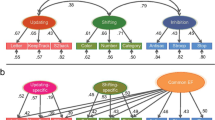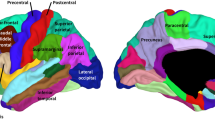Abstract
Purpose
Surgical resection of brain tumors may shift the location of cortical language areas. Studies of language reorganization primarily investigated left-hemispheric tumors irrespective of hemispheric language dominance. We used functional magnetic resonance imaging (fMRI) to investigate how tumors influence post-surgical language reorganization in relation to the dominant language areas.
Methods
A total of, 17 patients with brain tumors (16 gliomas, one metastasis) in the frontotemporal and lower parietal lobes planned for awake surgery underwent pre-surgical and post-surgical language fMRI. Language activation post-to-pre surgery was evaluated visually and quantitatively on the statistically thresholded images on patient-by-patient basis. Results were qualitatively compared between three patient groups: temporal, with tumors in the dominant temporal lobe, frontal, with tumors in the dominant frontal lobe and remote, with tumors in the non-dominant hemisphere.
Results
Post-to-pre-surgical distributions of activated voxels changed in all except the one patient with metastasis. Changes were more pronounced in the dominant hemisphere for all three groups, showing increased number of activated voxels and also new activation areas. Tumor resection in the dominant hemisphere (frontal and temporal) shifted the activation from frontal towards temporal, whereas tumor resection in the non-dominant hemisphere shifted the activation from temporal towards frontal dominant areas.
Conclusion
Resection of gliomas in the dominant and in the non-dominant hemisphere induces postsurgical shifts and increase in language activation, indicating that infiltrating gliomas have a widespread influence on the language network. The dominant hemisphere gained most of the language activation irrespective of tumor localization, possibly reflecting recovery of pre-surgical tumor-induced suppression of these activations.




Similar content being viewed by others
References
Stippich C, Rapps N, Dreyhaupt J, Durst A, Kress B, Nennig E, Tronnier VM, Sartor K. Localizing and lateralizing language in patients with brain tumors: feasibility of routine preoperative functional MR imaging in 81 consecutive patients. Radiology. 2007;243:828–36.
Pillai JJ, Zaca D. Relative utility for hemispheric lateralization of different clinical fMRI activation tasks within a comprehensive language paradigm battery in brain tumor patients as assessed by both threshold-dependent and threshold-independent analysis methods. Neuroimage. 2011;54(Suppl 1):S136–45.
Perrone-Bertolotti M, Zoubrinetzky R, Yvert G, Le Bas JF, Baciu M. Functional MRI and neuropsychological evidence for language plasticity before and after surgery in one patient with left temporal lobe epilepsy. Epilepsy Behav. 2012;23:81–6.
Hamberger MJ, Cole J. Language organization and reorganization in epilepsy. Neuropsychol Rev. 2011;21:240–51.
Elkana O, Frost R, Kramer U, Ben-Bashat D, Schweiger A. Cerebral language reorganization in the chronic stage of recovery: a longitudinal fMRI study. Cortex. 2013;49:71–81.
Saur D, Lange R, Lange R, Baumgaertner A, Schraknepper V, Willmes K, Rijntjes M, Weiller C. Dynamics of language reorganization after stroke. Brain. 2006;129:1371–84.
Pillai JJ. Insights into adult postlesional language cortical plasticity provided by cerebral blood oxygen level-dependent functional MR imaging. AJNR Am J Neuroradiol. 2010;31:990–6.
Rosenberg K, Liebling R, Avidan G, Perry D, Siman-Tov T, Andelman F, Ram Z, Fried I, Hendler T. Language related reorganization in adult brain with slow growing glioma: fMRI prospective case-study. Neurocase. 2008;14:465–73.
Duffau H, Capelle L, Denvil D, Sichez N, Gatignol P, Lopes M, Mitchell MC, Sichez JP, Van Effenterre R. Functional recovery after surgical resection of low grade gliomas in eloquent brain: hypothesis of brain compensation. J Neurol Neurosurg Psychiatry. 2003;74:901–7.
Desmurget M, Bonnetblanc F, Duffau H. Contrasting acute and slow-growing lesions: a new door to brain plasticity. Brain. 2007;130:898–914.
Duffau H, Sichez JP, Lehéricy S. Intraoperative unmasking of brain redundant motor sites during resection of a precentral angioma: evidence using direct cortical stimulation. Ann Neurol. 2000;47:132–5.
Robles SG, Gatignol P, Lehéricy S, Duffau H. Long-term brain plasticity allowing a multistage surgical approach to World Health Organization Grade II gliomas in eloquent areas. J Neurosurg. 2008;109:615–24.
Spreer J, Arnold S, Quiske A, Wohlfarth R, Ziyeh S, Altenmüller D, Herpers M, Kassubek J, Klisch J, Steinhoff BJ, Honegger J, Schulze-Bonhage A, Schumacher M. Determination of hemisphere dominance for language: comparison of frontal and temporal fMRI activation with intracarotid amytal testing. Neuroradiology. 2002;44:467–74.
Spreer J, Ziyeh S, Wohlfahrt R, Hammen A, Schreiber A, Hubbe U, Schmider K, Schumacher M. Vergleich verschiedener Paradigmen für die fMRT zur Bestimmung der Hemisphärendominanz für sprachliche Funktionen. Klin Neuroradiol. 1998;8:173–81.
Jenkinson M, Beckmann CF, Behrens TEJ, Woolrich MW, Smith SM. FSL. Neuroimage. 2012;62:782–90.
Jenkinson M, Bannister P, Brady M, Smith S. Improved optimization for the robust and accurate linear registration and motion correction of brain images. Neuroimage. 2002;17:825–41.
Smith SM. Fast robust automated brain extraction. Hum Brain Mapp. 2002;17:143–55.
Woolrich MW, Ripley BD, Brady M, Smith SM. Temporal autocorrelation in univariate linear modeling of FMRI data. Neuroimage. 2001;14:1370–86.
Abbott DF, Waites AB, Lillywhite LM, Jackson GD. fMRI assessment of language lateralization: an objective approach. Neuroimage. 2010;50:1446–55.
Jansen A, Menke R, Sommer J, Förster AF, Bruchmann S, Hempleman J, Weber B, Knecht S. The assessment of hemispheric lateralization in functional MRI–robustness and reproducibility. Neuroimage. 2006;33:204–17.
Knecht S, Jansen A, Frank A, van Randenborgh J, Sommer J, Kanowski M, Heinze HJ. How atypical is atypical language dominance? Neuroimage. 2003;18:917–27.
Specht K, Willmes K, Shah NJ, Jäncke L. Assessment of reliability in functional imaging studies. J Magn Reson Imaging. 2003;17:463–71.
Baciu MV, Watson JM, Maccotta L, McDermott KB, Buckner RL, Gilliam FG, Ojemann JG. Evaluating functional MRI procedures for assessing hemispheric language dominance in neurosurgical patients. Neuroradiology. 2005;47:835–44.
Ojemann GA. Individual variability in cortical localization of language. J Neurosurg. 1979;50:164–9.
Corina DP, Loudermilk BC, Detwiler L, Martin RF, Brinkley JF, Ojemann G. Analysis of naming errors during cortical stimulation mapping: implications for models of language representation. Brain Lang. 2010;115:101–12.
Szelényi A, Bello L, Duffau H, Fava E, Feigl GC, Galanda M, Neuloh G, Signorelli F, Sala F. Intraoperative electrical stimulation in awake craniotomy: methodological aspects of current practice. Neurosurg Focus. 2010;28:E7.
Huber W, Weniger D, Poeck K, Willmes K. The Aachen Aphasia Test Rationale and construct validity (author’s transl). Nervenarzt. 1980;51:475–82.
Wang L, Chen D, Yang X, Olson JJ, Gopinath K, Fan T, Mao H. Group independent component analysis and functional MRI examination of changes in language areas associated with brain tumors at different locations. PLoS One. 2013;8:e59657.
Kundu B, Penwarden A, Wood JM, Gallagher TA, Andreoli MJ, Voss J, Meier T, Nair VA, Kuo JS, Field AS, Moritz C, Meyerand ME, Prabhakaran V. Association of functional magnetic resonance imaging indices with postoperative language outcomes in patients with primary brain tumors. Neurosurg Focus. 2013;34:E6.
Partovi S, Jacobi B, Rapps N, Zipp L, Karimi S, Rengier F, Lyo JK, Stippich C. Clinical standardized fMRI reveals altered language lateralization in patients with brain tumor. AJNR Am J Neuroradiol. 2012;33:2151–7.
Thiel A, Herholz K, Koyuncu A, Ghaemi M, Kracht LW, Habedank B, Heiss WD. Plasticity of language networks in patients with brain tumors: a positron emission tomography activation study. Ann Neurol. 2001;50:620–9.
Giese A, Kluwe L, Laube B, Meissner H, Berens ME, Westphal M. Migration of human glioma cells on myelin. Neurosurgery. 1996;38:755–64.
Kallenberg K, Goldmann T, Menke J, Strik H, Bock HC, Stockhammer F, Buhk JH, Frahm J, Dechent P, Knauth M. Glioma infiltration of the corpus callosum: early signs detected by DTI. J Neurooncol. 2013;112:217–22.
Ulmer JL, Hacein-Bey L, Mathews VP, Mueller WM, DeYoe EA, Prost RW, Meyer GA, Krouwer HG, Schmainda KM. Lesion-induced pseudo-dominance at functional magnetic resonance imaging: implications for preoperative assessments. Neurosurgery. 2004;55:569–79. (discussion 580–1).
Kell CA, Morillon B, Kouneiher F, Giraud A. Lateralization of speech production starts in sensory cortices–a possible sensory origin of cerebral left dominance for speech. Cereb Cortex. 2011;21:932–7.
Gould RL, Arroyo B, Brown RG, Owen AM, Bullmore ET, Howard RJ. Brain mechanisms of successful compensation during learning in Alzheimer disease. Neurology. 2006;67:1011–7.
Nelissen N, Dupont P, Vandenbulcke M, Tousseyn T, Peeters R, Vandenberghe R. Right hemisphere recruitment during language processing in frontotemporal lobar degeneration and Alzheimer’s disease. J Mol Neurosci. 2011;45:637–47.
Mahdavi A, Houshmand S, Oghabian MA, Zarei M, Mahdavi A, Shoar MH, Ghanaati H. Developing optimized fMRI protocol for clinical use: comparison of different language paradigms. J Magn Reson Imaging. 2011;34:413–9.
Acknowledgements
We would like to thank our patients and their families for their cooperation.
Funding
None.
Previous Full/Part Presentation of Data
None.
Conflict of Interest
The authors declare that they have no conflict of interest.
Author information
Authors and Affiliations
Corresponding author
Rights and permissions
About this article
Cite this article
Avramescu-Murphy, M., Hattingen, E., Forster, MT. et al. Post-Surgical Language Reorganization Occurs in Tumors of the Dominant and Non-Dominant Hemisphere. Clin Neuroradiol 27, 299–309 (2017). https://doi.org/10.1007/s00062-015-0496-6
Received:
Accepted:
Published:
Issue Date:
DOI: https://doi.org/10.1007/s00062-015-0496-6




